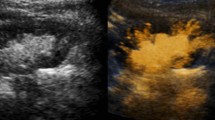Abstract
A randomized, double-blind clinical trial was performed to compare a higher dose of conventional ionic contrast media (diatrizoate) with a lower dose of a new, nonionic contrast material (ioversol) for excretory urography (EU). One hundred twenty patients were randomized to receive either 100 ml of diatrizoate (Renografin-60) or 75 ml of ioversol (Optiray-320). Despite the lower iodine dose, the use of ioversol resulted in significantly better opacification of the calyces, renal pelves, and ureters. There was no significant difference in renal parenchymal opacification, opacification of the urinary bladder, or distention of the collecting system. We conclude that high-quality EU can be performed with a lower iodine dose using ioversol.
Similar content being viewed by others
References
Palmer FJ: The R.A.C.R. survey of intravenous contrast media reactions: A preliminary report.Australas Radiol 32:8–11, 1988
Katayama H, Yamaguchi K, Kozuka T, et al.: Adverse reactions to ionic and nonionic contrast media: A report from the Japanese Committee on the Safety of Contrast Media.Radiology 175:621–628, 1990
Spataro RF, Katzberg RW, Fischer HW, McMannis MJ: High-dose clinical urography with the low-osmolality contrast agent Hexabrix: Comparison with a conventional contrast agent.Radiology 162:9–14, 1987
Spataro RF: Urography. In Skucas J (ed):Radiographic Contrast Agents. Rockville, MD: Aspen Publishers, 1989, pp 245–269.
Eyes BE, Goldman M, Nixon TE, Scally J, Brown A: Low dose low osmolar intravenous urography.Clin Radiol 38:403–405, 1987
Sjöberg S, Almén T, Golman K: Excretion of contrast media for urography. Urine volume and iodine concentration during free urine flow in rabbits.J Belge Radiol 62:451–457, 1979
Wolf GL: Safer, more expensive iodinated contrast agents: How do we decide?Radiology 159:557–558, 1986
Levorstad K, Kolbenstvedt A, Sommerfelt SC,et al.: Tolerability and diagnostic usefulness of iohexol in urography: An open multicentre clinical trial.Acta Radiol [Diagn] 23:491–496, 1982
McClennan BL, Ling D, Rholl KS, James M: Urography with a low osmolality contrast agent: comparison of Hexabrix with Conray 325.Invest Radiol 21:144–150, 1986
Rankin RN, Hong Tai Eng FW: Iohexol vs. diatrizoate: A comparative study in intravenous urography.Invest Radiol 20:(Suppl):S112-S114, 1985
Spataro RF, Fischer HW, Boylan L: Urography with low-osmolality contrast media: Comparative urinary excretion of iopamidol, Hexabrix, and diatrizoate.Invest Radiol 17:494–500, 1982
Winfield AC, Dray RJ, Kirchner FK, Muhletaler CA, Price RR: Iohexol for excretory urography: A comparative study.AJR 141:571–573, 1983
Dawson P, Heron C, Marshall J: Intravenous urography with low-osmolality contrast agents: Theoretical considerations and clinical findings.Clin Radiol 35:173–175, 1984
Spataro RF: New and old contrast agents: pharmacology, tissue opacification, and excretory urography.Urol Radiol 10:2–5, 1988
Jacobsson BF, Jorulf H, Kalantar MS, Narasimham DL: Nonionic versus ionic contrast media in excretory urography: Clinical trial in 1,000 consecutive patients.Radiology 167:601–605, 1988
Fjelldal À, Nordshus T, Eriksson J: Experiences with iohexol (Omnipaque) at urography.Pediatr Radiol 17:491–492, 1987
Lasser EC, Berry CC, Talner LB,et al.: Pretreatment with corticosteroids to alleviate reactions to intravenous contrast materal.N Engl J Med 317:845–849, 1987
Author information
Authors and Affiliations
Rights and permissions
About this article
Cite this article
Baker, M.K., Kopecky, K.K., Bogan, M. et al. Unequal doses of ioversol versus diatrizoate for urography. Urol Radiol 12, 168–172 (1990). https://doi.org/10.1007/BF02924000
Issue Date:
DOI: https://doi.org/10.1007/BF02924000




